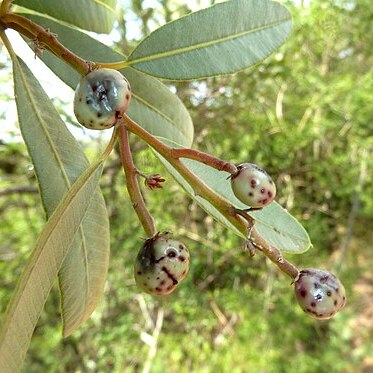Inflorescences terminal and axillary, shorter than the leaves, in the upper axils, forming a terminal panicle leafy at the base, the female ones laxer than the male ones; branches slender, shortly villous; pedicels of the female flowers 2·5–4 mm. long, those of the male ones shorter.
A small tree. It grows 8 m tall. The leaves are alternate and oblong. The leaves have rusty hairs underneath. The leaves are 12 cm long by 3 cm wide. The fruit are black, slightly fleshy and 8 mm across.
Tree, up to 7 m high, hairy. Leaves shortly petiolate, petioles up to 7 mm long, veins on undersurface prominent, margin thickened, slightly curled under, wavy. Fruits spherical. Flowers creamy white.
Young branches greyish-brown to cinnamon, cylindric, striate, densely lenticellate, ± pilose, the oldest glabrescent to glabrous.
Calyx-segments c. 2 × 1·25 mm., lanceolate-triangular, acute, externally densely villous.
Petals 3·5 × 2 mm., oblong-rectangular, obtuse and flat at the apex.
Drupe black, somewhat shining, 7–9 × 10 mm., globose or subglobose.
Stamens with filaments c. 1·5 mm. long; anthers c. 0·75 mm. long.
A small tree up to 7·5 m. tall.


